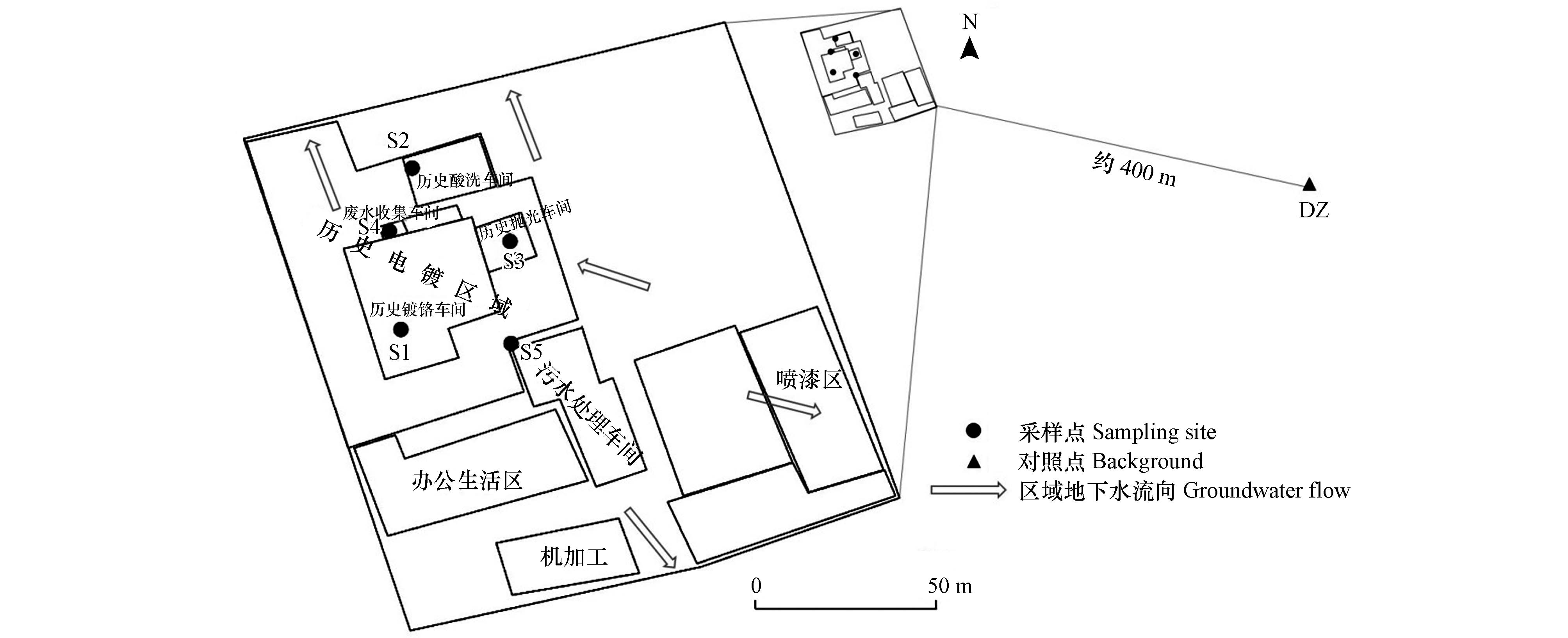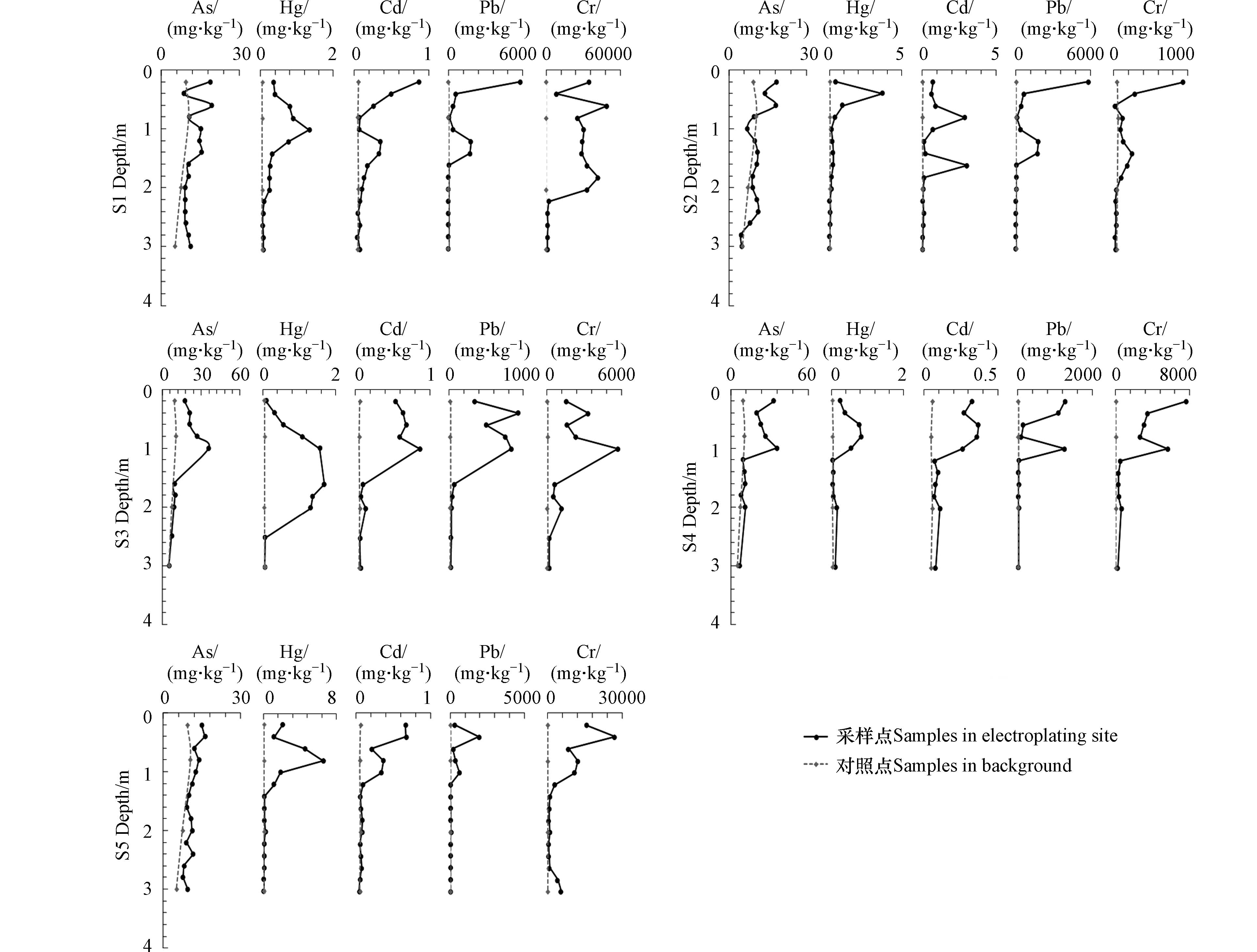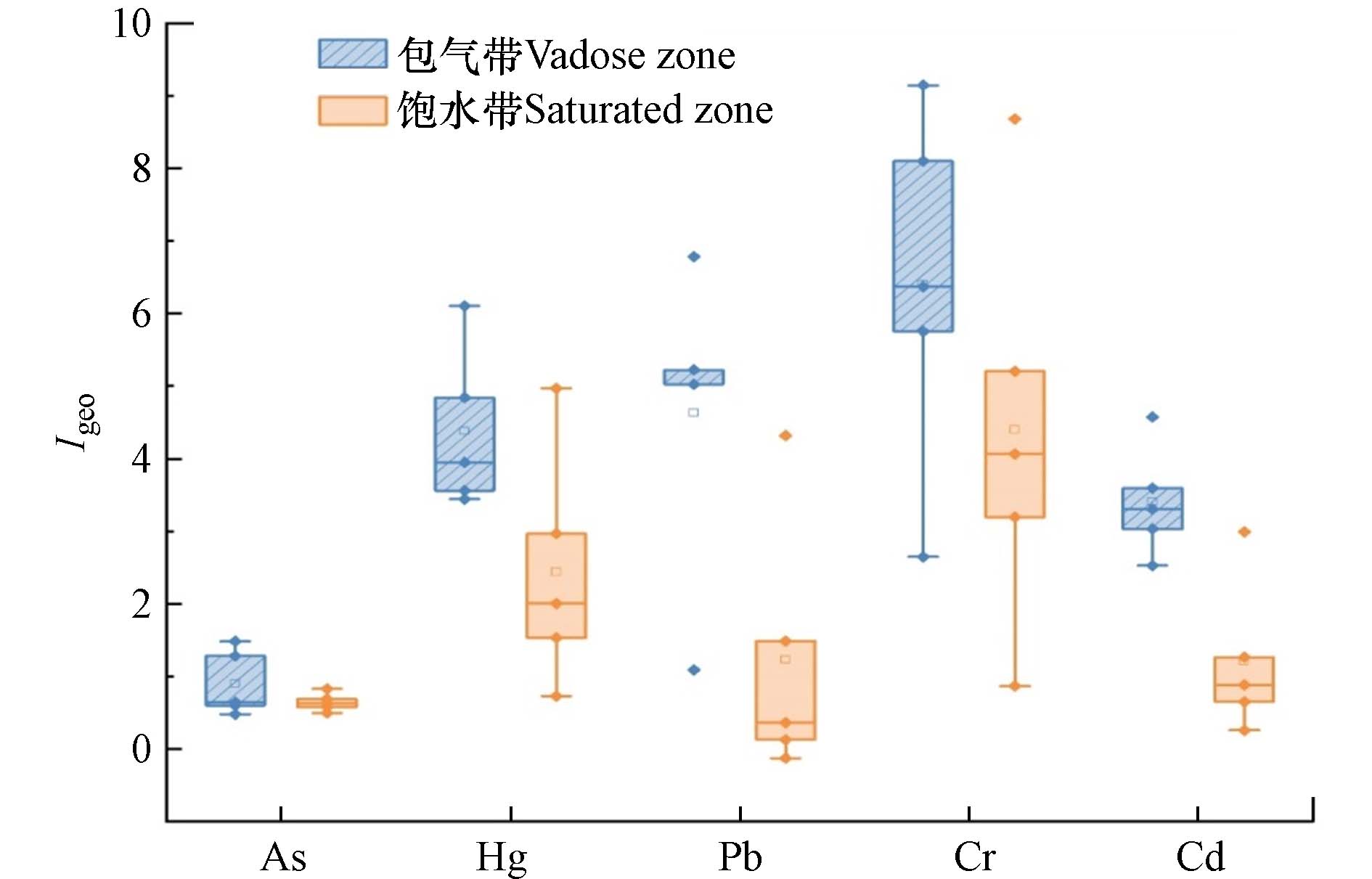-
土壤是人类活动产生的各种污染物的重要接收者,被认为是地球上最大的重金属汇. 伴随工业化发展,各种污染物不可避免的被引入到环境介质中. 研究表明,工业排放是城市土壤中重金属的主要来源之一[1],而电镀行业因其工艺流程会产生大量高浓度重金属废水和废渣,更是重金属排放大户,若未经妥善处理极易释放到环境中,造成环境污染. 随着城市化进程加快,大量电镀厂被废弃,但其造成的土壤中重金属的累积是短时间内难以消除的[2],残留在土壤中的重金属不仅对植物、土壤动物和微生物构成严重威胁,还可通过食物链对周围居民造成潜在高风险[3 − 6]. 此外,由于污染物的长期向环境土壤中输入以及在降水等作用下的淋溶迁移[7],表层土壤累积的重金属会向下迁移运输,严重时可造成地下水的污染,危害人体健康[8 − 11]. 因此,了解土壤环境中重金属的迁移和转化对于实施相关风险控制策略至关重要.
目前国内外开展的土壤重金属污染的研究多关注于表层土壤[12 − 14],然而,从地表包气带土壤到饱水带及地下水是有密切物质联系的完整系统,想要全面诠释重金属在土壤中的分布特征及运输迁移途径,将土壤(包气带至饱水带)-地下水进行综合考虑是十分重要的. 此外,重金属在土壤中的赋存形态很大程度上决定了其土壤中的释放和迁移转化过程[15 − 17],因而对元素赋存状态的分析有助于表征其在土壤中的迁移特征. 目前对电镀污染场地土壤中重金属的相关研究主要关注于分布特征、污染风险评价和来源解析,对其迁移规律研究较少.
本研究选择上海市某废弃电镀厂作为研究对象,对其场地内包气带-饱水带土壤和地下水样品中重金属含量进行测定,综合重金属污染特征,探究重金属的垂向空间分布及迁移特征. 通过对电镀场地土壤重金属污染特征和迁移规律的了解,对于制定科学的环境管理和污染治理策略具有一定支撑作用.
-
研究区域位于上海东南部某关闭电镀厂,该企业主要涉及金属表面镀层加工、表面处理、蚀刻、机加工、喷漆和三废尾端处理等生产加工活动,生产时间近60年,在2016年底电镀厂关停后,该地区被废弃. 由于早期生产环保措施落后,该电镀厂在生产运营期间造成了较严重的环境污染. 2021年企业拆除前主要存在电镀区、喷漆区、废水处理区、机加工区、办公生活区等.
企业所在地区属亚热带季风气候,年降水量约1500 mm,年平均气温16—18 ℃. 其地貌类型为冲积平原平地,区域土层从表层至深层主要为杂填土、粉质黏土和淤泥质粉质黏土. 地块地下水位埋深为0.5—3.3 m,流向为自南向北. 研究区域1 km范围内,存在居民区、学校、地表水等敏感目标.
-
为探究场地包气带-饱水带全剖面土壤重金属的分布特征,2022年1月研究组在场地污染相较严重区域(历史生产活动区域)采集了5个土壤柱样品(S1—S5),另在距企业厂界东南侧约400 m农田区域采集一个土壤柱(DZ)作为对照点,对照点所在区域历史用地类型均为农田. 采样点分布见图1. S1—S5点位位置分别对应历史镀铬车间、酸洗车间、抛光车间、废水收集车间以及污水处理车间外排污口. 根据采样点位潜水埋深,土壤采集深度为3 m. 用贝勒管采集S1—S5点位相应地下水监测井中地下水样品,采样深度为潜水面0.5 m以下. 地下水埋深使用水位仪测定,现场测定地下水pH和电导率(EC).
土壤柱带回实验室后,每隔20 cm土壤分层混合为一份,共采集70个土壤样品(因S3和S4部分饱水带深层样品取样困难导致损失). 除去石子和建筑垃圾等异物,置于阴凉通风处自然风干,研磨过100目网筛待测. 土壤颗粒组成分析采用《森林土壤颗粒组成(机械组成)的测定》(LY/T1225-1999)测定. 土壤样品重金属(Hg、Pb、Cd、Cr和As)检测分析方法依据《土壤环境质量 建设用地土壤污染风险管控标准(试行)》(GB36600-2018)进行. 其中Pb和Cd元素采用石墨炉原子吸收分光光度法测定,Hg和As元素采用微波消解/原子荧光法测定,Cr元素采用火焰原子吸收分光光度法测定. 重金属形态的测定参照《土壤和沉积物 13个微量元素形态顺序提取程序》(GB/T 25282)进行顺序提取测定不同赋存形态,包括水溶态(F1)、弱酸提取态(F2)、可还原态(F3)、可氧化态(F4)和残渣态(F5). 地下水中重金属Cr、Pb、Cd采用电感耦合等离子体质谱法测定,As和Hg采用原子荧光法测定,Cr(Ⅵ)采用分光光度法测定. 每个样品重复测定3次,平行样本间的相对标准偏差≤5%,同时采用同种方法检测空白样品、空白加标和样品加标进行质量控制,回收率在90%—110%范围内,满足质量控制要求.
-
地累积指数法(Geo-accumulation indexes, Igeo)是由德国科学家Muller[18]提出的可用于研究重金属污染程度的定量评价方法,该方法同时考虑人为污染因素、环境地球化学背景值和自然成岩作用的影响,被广泛于土壤重金属的污染评价中[19]. 其计算公式为:
式中,
$ {I}_{\mathrm{g}\mathrm{e}\mathrm{o}} $ 为地累积指数,Ci为重金属i的实测值,mg·kg−1;Bi为重金属i的背景值,mg·kg−1,本研究采用对照点相应层位重金属检测值;K是考虑成岩作用或非常小的人为影响引起背景值变动而设置的常数,通常取值为1.5[13,19]. 根据Igeo将污染程度划分为7级(0—6级),Igeo<0,无污染;0≤Igeo<1,轻度污染;1≤Igeo<2,偏中度污染;2≤Igeo<3,中度污染;3≤Igeo<4,偏重度污染;4≤Igeo<5,重度污染;Igeo≥5时,极重度污染. -
重金属在土壤中的迁移量取决于其迁移能力,迁移能力主要由重金属的赋存形态决定,形态组成不同迁移能力也不同[20]. 迁移系数[20,21]被用来评估土壤中重金属的迁移能力,其计算公式如下:
式中,MF为土壤中重金属迁移系数,F1—F5分别为重金属的水溶态、弱酸提取态、可还原态、可氧化态和残渣态含量.
-
采用Microsoft Excel 2016和Origin 2023b软件对土壤样品中重金属含量数据进行描述性统计分析及绘图,使用ArcGIS 10. 2进行空间分析与制图,采用SPSS 26软件进行数据相关性分析.
-
研究区域土壤pH范围为3.80—9.08(平均值7.94)(表1),除S1呈酸性外,S2—S5整体呈弱碱性且各剖面并没有显著差异. S1位于历史镀铬车间,镀液为酸性,表明可能存在镀液泄漏至土壤中的现象. 根据土壤粒度分级分类标准对采样点剖面土壤质地进行划分,并绘制剖面岩性分布图(图2). 由图2可知,研究区域地下水位埋深在0.66—1.42 m,S1—S5包气带厚度分别为0.66、0.89、1.42、1.14、1.01 m. 包气带土壤质地以粉(砂)粒(0.002—0.05 mm)为主,饱水带土壤质地以砂粒(0.05—2 mm)为主,粒度分布随剖面深度增加,粉(砂)粒占比下降,黏粒(< 0.002 mm)占比增加.
-
各点位(S1—S5)包气带-饱水带剖面土壤中重金属统计结果如表2和图3所示,Hg、Pb、Cd、Cr和As在各采样剖面的含量变化范围分别为:0.03—6.58、5.41—5831、0.04—3.04、18.05—49020、4.81—35.81 mg·kg−1. 剖面中Hg、Pb和Cr的平均值远远高于对照点,分别是对照点各重金属平均值的13.67、17.89、138.00倍,表明这些金属在土壤中存在明显累积,尤其Cr的累积最为严重. 由重金属空间分布图(图3)可知,该电镀厂不同车间重金属累积情况存在差异,As和Cd的高值区主要位于废水收集车间(S4),Hg的高值区主要位于污水处理车间(S5),Pb的高值区主要位于历史镀铬车间(S1),位于历史镀铬车间和污水处理车间的S1和S5点位Cr污染最为严重. As和Cd的平均值是对照点的1.65倍和6.06倍,累积量相较于另3种重金属较轻. 该结果与电镀企业生产所涉及主要重金属相对应. 研究区域包气带中Hg、Pb、Cd、Cr 和As的含量变化范围分别为:0.09—6.58、19.49—5831、0.20—2.91、18.05—49020、8.67—35.81 mg·kg−1,远高于相应点位饱水带土壤中各重金属含量范围(0.03—1.68、5.41—1817.21、0.04—3.04、20.75—42090、4.81—15.50 mg·kg−1). Hg、Pb、Cd、Cr 和As在包气带土壤中的含量平均值均远超对照点含量值,分别达到对照点的28.53、38.71、11.59、172.15、1.99倍,表明此5种重金属在包气带土壤中存在严重累积,反映出电镀生产活动对土壤中这些重金属含量造成了一定程度的影响. 各元素含量与我国《土壤环境质量 建设用地土壤污染风险管控标准(试行)》(GB 36600-2018)对比,仅Pb存在超第二类用地筛选值现象,最大超标倍数为6.29倍. 因Cr没有相应标准,此处不做评价. 根据生产工艺,电镀环节镀液含有Cr等重金属,镀件、阳极氧化件和不锈钢管材成分包含Pb、Mn等重金属,镀液渗漏滴漏、污水池渗漏、电镀污泥堆放转移过程中的跑冒滴漏等均可能导致重金属残留于地面,早期企业相关措施难以保障防渗屏障,污染物可能因此直接渗入土壤中;金属镀件机加工产生的金属粉尘可通过干沉降导致重金属在地表累积,而引起土壤污染.
变异系数可反映介质中元素含量的平均变异程度,变异系数越大,表明土壤样品中金属含量的离散程度越高,受人类活动的影响也越大[10]. 研究区域土壤中Hg、Pb、Cd和Cr均表现为强变异(变异系数>100%)(表2),表明这4种重金属空间差异显著,受人类活动等外在因素影响较大. 各点位重金属统计结果(表3)显示,Hg、Pb、Cr和Cd在5个剖面中均表现出强变异,说明各点位土壤中5种重金属的垂向变异性较大,存在明显的垂向迁移现象. 重金属含量的强变异性可能归因于生产过程中原/废料堆放、镀液、电镀废水的泄露、污水处理管道的泄露以及铬酸雾、金属粉尘的干湿沉降等. 这些过程可能会造成表层土壤的重金属污染,由于降水淋溶下渗等作用,污染物发生垂向迁移,对深层土壤和地下水造成污染. S1—S5剖面中As的平均值略高于对照点检测值且为中等变异水平,表明As在土壤中可能存在累积,但受人类活动等外在因素干扰相对较小.
为进一步了解重金属迁移行为,对5种元素的垂直分布特征进行探究. 根据S1—S5剖面包气带-饱水带土壤垂向分布特征图(图4),Hg、Pb、Cd和Cr的分布整体呈现随土壤深度增加先下降后增加再下降的趋势,到一定深度时含量达到平稳状态,而As随土壤深度的增加呈无规律的波动,无明显的增减趋势,这种迁移现象在之前的研究中也有类似报道[6]. 包气带层土壤重金属含量最高,且波动较大,土壤重金属含量在潜水面上下波动最大,存在显著下降再上升的现象. 表层土壤高浓度的重金属可在降雨淋溶的作用下向下迁移. 饱水带下层土壤重金属含量趋于平稳,不再随深度的增加有明显波动,表明土壤对重金属的迁移具有一定的屏障作用[22]. 研究表明,采样点与污染源距离、地势、土壤pH等理化性质等多种因素是影响重金属垂向分布差异的原因[22 − 23]. 与对照点相比,S1—S5剖面中重金属Hg、Pb、Cd和As含量分别在0.8—2.5、1.4—2.5、1.2—2.2、0.8—1.6 m处与对照点检测值保持同一含量水平,仅S2在2 m深度以下土壤中Cr含量降低至对照点水平,其余4个剖面在3 m深度时Cr含量仍高于对照点检测值1—2个数量级,表明不同生产功能车间所造成的土壤重金属含量及迁移影响不同. 研究区域Cr垂向迁移深度最深,历史电镀生产活动已经造成饱水带土壤Cr的严重污染. 通常,土壤剖面中重金属的保留和迁移与其可利用性和迁移性有关,取决于元素本身化学性质和土壤理化性质(如pH值、质地等)的综合作用[22]. 已有研究表明,Pb、Cr等重金属进入土壤后,会随水分的运移在土壤孔隙中迁移[24],地下水的pH值会会影响到土壤对Cr的吸附作用,在酸性条件下(2 < pH < 6.5)土壤吸附量随pH增加而增加,中性至碱性条件下,吸附量随地下水pH值增加而减少[11]. 调查点位地下水pH在7.0—8.5之间,因此土壤对Cr的吸附量减少,利于其向深层土壤迁移,因而造成Cr在3 m深度仍有较高检出值.
采用地累积指数法对研究区域包气带和饱水带土壤5种重金属进行污染程度评价,结果(图5)表明,包气带土壤重金属Igeo平均值由大到小依次为:Cr(6.40)> Pb(4.63)> Hg(4.38)> Cd(3.41)> As(0.89),均高于饱水带土壤中相应重金属Igeo平均值. 包气带中Hg、Pb、Cd和Cr污染程度为偏重度至极重度污染,饱水带中此4种重金属污染水平在偏中度至重度污染. 单个点位来看,As在S3(抛光车间)和S4(废水收集车间)包气带中存在偏中度污染,在其余剖面均为轻度污染程度. Pb和Cr在S1(历史镀铬车间)、S3、S4和S5(污水处理车间外排污口)剖面包气带中污染程度达到极重度污染,甚至Cr元素在S1和S5饱水带土壤中仍达到极重度污染程度.
研究区域土壤剖面中各重金属含量与土壤粒度、pH、采样深度之间的相关性分析结果如表4所示,重金属含量与采样深度均呈显著负相关(P < 0.05),与土壤黏粒和粉(砂)粒占比呈显著负相关,与砂粒占比呈显著正相关. 土壤颗粒的粒径对重金属在土壤中的浓度、分布和迁移性有重要影响[25 − 27]. 早期研究表明,城市土壤中重金属优先在细颗粒中富集[28],与砂土相比,黏土对重金属的吸附量更高[20-21,29],黏粒含量较高的土壤,存在具有较大阳离子交换量和比表面积的黏土矿物,具有较高的吸附能力. 然而本研究结果相反,重金属含量与黏粒的占比呈反比. 一些研究学者也发现,重金属在较粗的土壤分部中更加富集,归因于所研究土壤性质的差异[9,30],砂粒含量较高的土壤存在Pb、Cd等重金属在黏粒和粉粒的负重低于砂粒[31],室内土柱淋溶实验结果表明土壤粗颗粒(0.5—2.0 mm)对Cd等重金属累积量的贡献率较大[32].
-
通常重金属总量被用来评估土壤污染的风险,实际却忽略了重金属在土壤中的释放和迁移过程. 土壤中重金属的固定和迁移能力很大程度上取决于其与土壤的结合形态,重金属形态组成不同,其迁移能力也不同[33]. 通过连续提取法对研究区域土壤污染最为严重的重金属Cr的赋存形态进行测定分析,采用迁移系数法[20-21]计算分析土壤中重金属的迁移能力. 结果如图6所示,包气带土壤中Cr主要以被铁锰氧化物吸持的可还原态存在(图6a),占各形态总和的40.7%—73.5%,易迁移组分(水溶态和弱酸提取态)占比2.2%—32.4%;随着土壤深度的增加,饱水带中可还原态占比有所降低,残渣态占比增加(图6b). 此结果与以往研究结果一致[34]. 不同点位Cr赋存形态占比差异明显. 包气带土壤Cr的迁移系数在2.2%—32.4%之间,饱水带土壤Cr的迁移系数在4.1%—46.5%之间,同一点位包气带Cr的迁移系数略低于饱水带,即饱水带中Cr的迁移能力更强,说明Cr在饱水带中的污染不容忽视. 土壤总Cr含量较高的2个点位(S1、S5),Cr的迁移能也较强,表明污染物的总量影响着其迁移能力.
采用Spearman相关系数分析,进一步探讨重金属Cr不同赋存形态与土壤环境的关系(表5),结果表明,pH、含水率与不同Cr形态相关性较弱. 包气带Cr迁移能力与黏粒含量呈显著负相关(P < 0.05),与砂粒含量呈显著正相关(P < 0.01),表明土壤颗粒大小是影响重金属迁移能力的重要影响因素之一. 研究表明,Cr(Ⅵ)在渗透系数较大的细砂中的迁移速率大于渗透系数较小的粉质黏土,粉质黏土对Cr(Ⅵ)的迁移有阻碍作用[35]. 而饱水带中Cr各形态与土壤性质无明显相关性,可能受到地下水复杂环境的影响.
-
S1—S5点位浅层地下水中重金属含量如表6所示,所有地下水采样点位Pb均低于检出限,Hg和Cd在部分点位有检出,Cr含量远高于对照点检测值,是对照点地下水中Cr的915—3533333倍,采样点地下水中Cr(Ⅵ)浓度均超Ⅳ类水标准限值,超标倍数在146—7760倍范围,表明土壤Cr的污染已经造成了地下水的严重污染,尤其是位于镀铬车间的S1点位地下水Cr污染最为严重. 对比土壤和地下水中Cr含量(图7a),在包气带和饱水带土壤Cr含量较高的点位,其地下水中Cr含量也相对较高. 相关性分析结果表明(图7b),地下水中Cr含量与EC、包气带和饱水带土壤Cr呈显著正相关,与pH相关性不显著. S1点位地下水埋深最浅,包气带厚度小且渗透系数较大的砂粒占比较高,对地下水的防污性能较弱,加之土壤中Cr的含量极高,在降水等作用下土壤中的Cr溶滤到地下水中,致使该点位出现地下水污染最严重的现象,S1点位EC值为1415 μS·cm−1,高于其它点位,可能是历史镀铬车间生产过程产生的液体下渗导致地下水中离子含量高于其它点位,而地下水中高离子含量可增加土壤中重金属的迁移率进而增加土壤-地下水系统中水相中的重金属浓度[10,36]. S2—S4点位包气带厚度和细颗粒占比相对较高,且包气带Cr的迁移能力较低,因此下渗到饱水带土壤和地下水中的Cr含量较低;虽然S5点位包气带Cr含量仅次于S1点位,但由于其地下水埋深较深,且土壤中渗透系数较小的粉粒和黏粒占比高,导致其地下水中Cr含量远低于S1点位. 以上结果表明,地下水中重金属含量受土壤重金属含量、水位埋深和土壤颗粒组成的影响.
-
本研究通过对废弃电镀厂土壤剖面和地下水中重金属的污染状况、垂向分布和赋存形态进行概括分析,明确了典型重金属在土壤中的迁移特征. 该场地土壤已受到不同程度的重金属污染,Cr和Pb是土壤中的主要污染物,主要是由于电镀生产活动原辅料、工艺及环保措施落后导致. Hg、Pb、Cd和Cr的总量随土壤深度的增加整体呈降低趋势,直至饱水带下层趋于稳定,说明土壤对重金属的迁移具有一定屏障作用. Cr在饱水带土壤中的迁移能力强于包气带土壤,污染不容忽视. 污染物的输入量和土壤颗粒大小是影响Cr迁移能力的重要因素. 重金属Cr迁移到饱水带中已造成地下水的严重污染,地下水中重金属含量受土壤重金属含量、土壤颗粒组成和水位埋深的影响.
典型电镀场地重金属污染及迁移特征
Contamination and migration characteristics of heavy metals at a typical electroplating site
-
摘要: 重金属污染是电镀场地普遍现象,研究其土壤地下水中重金属污染特征和迁移影响因素,对后续环境管理和修复策略的选择具有重要意义. 本文以上海市某废弃电镀厂作为研究对象,选择污染较为严重的5个区域及1个对照点,采集70个土壤样品和6个地下水样品,测定分析不同深度土壤和地下水中重金属(Hg、Pb、Cd、Cr和As)空间分布特征,结合土壤质地探讨了重金属的迁移影响因素. 结果表明,该场地土壤已受到不同程度的重金属污染,Hg、Pb、Cr和Cd的垂向分布均呈现随土壤深度增加而下降趋势,到一定深度时含量达到平稳状态,整体上包气带土壤重金属污染程度远高于饱水带,但是As无明显增减趋势. 相关性分析结果表明,土壤粒径是影响重金属垂向迁移的重要因素. 根据迁移系数的计算结果,饱水带土壤中Cr的迁移能力相较于包气带更强,说明饱水带中Cr的污染不容忽视. 土壤高含量的Cr已造成地下水Cr的严重污染. 土壤重金属含量、颗粒组成和水位埋深是影响地下水重金属含量的重要因素.Abstract: Heavy metal contamination is a common issue at electroplating sites. It is important to investigate the characteristics and migration of heavy metals in the soil and groundwater for subsequent environmental management and remediation strategies. In this study, a defunct electroplating factory in Shanghai was selected as the research site. A total of 70 soil samples and 6 groundwater samples were collected from five heavily contaminated sites and one control point. The spatial distribution characteristics of heavy metals (Hg, Pb, Cd, Cr, and As) in soil at different depths and groundwater were determined and analyzed, and the influencing factors of heavy metals migration were explored in combination with soil texture. The results showed that the soil at the electroplating plant had been contaminated to varying degrees with heavy metals. The vertical distribution of Hg, Pb, Cr, and Cd in the soil exhibits a decreasing trend with increasing soil profile depth, reaching a stable state at a certain depth. Overall, the levels of heavy metal contamination were much higher in the vadose zone soil than in the saturated zone soil. While, there is no significant trend for As to increase or decrease as the soil profile depth increases. Correlation analysis results indicate that soil particle size is a critical factor affecting the vertical migration of heavy metals. Based on the calculation of migration coefficients, it is evident that the migration capacity of Cr in the saturated zone soil is stronger than in the vadose zone, indicating that the contamination of Cr in the saturated zone should not be underestimated. High levels of Cr in the soil have caused significant contamination of groundwater with Cr. Soil heavy metal content, soil particle composition and groundwater burial depth are important factors that affect the amount of heavy metal in groundwater.
-
Key words:
- electroplating site /
- heavy metal contamination /
- soil /
- migration
-

-
表 1 不同采样点剖面土壤pH分布特征
Table 1. pH values of soils
采样点
Sampling siteS1 S2 S3 S4 S5 最小值 3.80 7.40 8.26 7.68 7.68 最大值 8.61 8.91 9.08 8.79 8.48 平均值 6.64 8.12 8.59 8.36 8.19 表 2 研究区域土壤剖面重金属含量
Table 2. Statistical table of heavy metal contents in soil
元素
ElementAs/(mg·kg−1) Hg/(mg·kg−1) Pb/(mg·kg−1) Cr/(mg·kg−1) Cd/(mg·kg−1) 最大值 35.81 6.58 5831 49020 3.04 最小值 4.81 0.03 5.41 18.05 0.04 平均值 13.17 0.64 341.34 6934.68 0.33 中位值 10.87 0.24 28.25 1119.00 0.12 标准差 6.76 1.10 829.26 11983.08 0.53 变异系数/% 51.33 172.34 242.94 172.80 159.42 对照点平均值 8.19 0.05 19.08 50.25 0.06 第二类用地筛选值 60 38 800 — 65 表 3 采样点位包气带和饱水带重金属含量
Table 3. Statistical table of heavy metal contents at each sampling site
采样点
Sampling siteAs/(mg·kg−1) Hg/(mg·kg−1) Pb/(mg·kg−1) Cr/(mg·kg−1) Cd/(mg·kg−1) S1 最大值 19.41 1.33 5831.00 49020.00 0.87 最小值 8.67 0.06 9.89 1095.00 0.05 平均值 12.13 0.39 735.53 21460.47 0.21 平均值a 15.61 0.51 2289.36 30638.00 0.54 平均值b 11.26 0.36 347.07 19166.08 0.13 变异系数 0.30 0.96 2.09 0.79 1.06 S2 最大值 18.56 3.66 86.00 932.60 3.04 最小值 4.81 0.03 5.41 18.05 0.06 平均值 10.59 0.46 23.40 152.08 0.67 平均值a 15.11 1.35 44.06 337.71 1.31 平均值b 8.95 0.13 15.89 84.58 0.44 变异系数 0.37 2.00 0.88 1.52 1.46 S3 最大值 35.46 1.68 935.46 5719.00 0.86 最小值 9.16 0.09 32.44 512.10 0.07 平均值 18.75 1.00 440.56 2112.75 0.45 平均值a 24.32 0.73 675.69 2913.80 0.66 平均值b 9.47 1.46 48.67 777.67 0.10 变异系数 0.50 0.60 0.85 0.81 0.68 S4 最大值 35.81 0.82 1272.30 7611.00 0.37 最小值 8.25 0.05 11.78 308.10 0.07 平均值 19.09 0.32 398.65 2450.90 0.20 平均值a 27.94 0.55 774.99 4476.60 0.32 平均值b 10.24 0.08 22.31 425.20 0.09 变异系数 0.54 0.96 1.41 1.04 0.63 S5 最大值 16.12 6.58 1924.97 27050.00 0.67 最小值 7.61 0.03 6.92 346.40 0.04 平均值 11.18 1.20 237.63 6096.47 0.19 平均值a 13.89 3.24 675.03 14860.40 0.45 平均值b 9.83 0.19 18.93 1714.50 0.07 变异系数 0.22 1.61 2.10 1.25 1.13 平均值a:包气带中重金属含量平均值,平均值b:饱水带中重金属含量平均值.
meana: the average content of heavy metals in the vadose zone; meanb: the average content of heavy metals in the saturated zone.表 4 研究区域土壤剖面中重金属与土壤性质之间的相关性
Table 4. Correlation between heavy metals and soil properties of the soil profile in the study area
As Hg Pb Cr Cd pH 黏粒
Clay砂粒
Sand(粉)砂粒
Silt含水率
Soil moisture采样深度
DepthAs 1 Hg 0.18 1.00 Pb 0.41** 0.05 1.00 Cr 0.15 0.14 0.46** 1.00 Cd 0.20 0.09 0.17 −0.02 1.00 pH 0.08 0.01 −0.05 −0.59** −0.20 1.00 黏粒 −0.58** −0.35** −0.42** −0.54** −0.10 0.14 1.00 砂粒 0.67** 0.33** 0.52** 0.528** 0.16 −0.06 −0.87** 1.00 粉砂粒 −0.63** −0.27* −0.50** −0.43** −0.17 −0.02 0.63** −0.93** 1.00 含水率 −0.53* −0.06 −0.52* −0.39 −0.38 −0.09 0.46* −0.67** 0.68** 1.00 采样深度 −0.61** −0.41** −0.42** −0.29* −0.40** −0.03 0.55** −0.70** 0.70** 0.68** 1.00 注:* 表示 P<0. 05;** 表示 P<0. 01. Note: * indicate P<0. 05 and ** indicate P<0. 01. 表 5 包气带土壤Cr形态相关性分析
Table 5. Correlation analysis of Cr occurrence forms and soil properties in vadose zone
pH 黏粒
Clay砂粒
Sand粉砂粒
Silt迁移系数
MF可还原态
Reucibled可氧化态
Oxidisable残渣态
Residual含水率
Soil moisturepH 1 黏粒 −0.56 1 砂粒 0.15 −0.90* 1 粉砂粒 0.05 0.6 −0.7 1 迁移系数 0.15 −0.90* 1.0** −0.7 1 可还原态 0.41 0.3 −0.6 0.5 −0.6 1 可氧化态 0.05 0.6 −0.7 1.0** −0.7 0.5 1 残渣态 −0.21 −0.1 0.2 −0.7 0.2 −0.6 −0.7 1 含水率 0.46 −0.4 0.3 0.2 0.3 −0.4 0.2 0 1 注:* 表示 P<0. 05;** 表示 P<0. 01. Note: * indicate P<0. 05; ** indicate P<0. 01. 表 6 地下水中重金属含量
Table 6. Heavy metal concentrations of groundwater in the study area
点位
Sampling sitepH EC/(μS·cm−1) As/(μg·L−1) Hg/(μg·L−1) Pb/(μg·L−1) Cr/(mg·L−1) Cd/(μg·L−1) Cr(Ⅵ) /(mg·L−1) S1 8.11 1415 0.30 1.3 <0.09 954.00 0.33 776.00 S2 7.58 845 2.10 <0.04 <0.09 12.30 3.82 11.10 S3 7.69 860 2.00 <0.04 <0.09 28.00 0.08 26.60 S4 7.90 707 1.70 <0.04 <0.09 29.10 <0.05 27.90 S5 7.05 912 1.65 <0.04 <0.09 15.2 <0.05 14.6 对照点 7.6 — 4.10 <0.04 <0.09 0.0003 <0.05 <0.004 GB/T 14848 IV — — 50.00 2.00 100.00 — 10.00 0.10 -
[1] 何博, 赵慧, 王铁宇, 等. 典型城市化区域土壤重金属污染的空间特征与风险评价[J]. 环境科学, 2019, 40(6): 2869-2876. doi: 10.13227/j.hjkx.201810057 HE B, ZHAO H, WANG T Y, et al. Spatial distribution and risk assessment of heavy metals in soils from a typical urbanized area[J]. Environmental Science, 2019, 40(6): 2869-2876 (in Chinese). doi: 10.13227/j.hjkx.201810057
[2] 耿治鹏, 宋颉, 王春林, 等. 污染场地土壤重金属污染空间特征分析—以某搬迁电镀厂为例[J]. 环境工程技术学报, 2023, 13(1): 295-302. doi: 10.12153/j.issn.1674-991X.20210617 GENG Z P, SONG J, WANG C L, et al. Spatial characteristics of soil heavy metal pollution in polluted sites: taking a relocated electroplating factory as an example[J]. Journal of Environmental Engineering Technology, 2023, 13(1): 295-302 (in Chinese). doi: 10.12153/j.issn.1674-991X.20210617
[3] SU W, LI X Y, ZHANG H S, et al. Migration and transformation of heavy metals in hyperaccumulators during the thermal treatment: a review[J]. Environmental Science and Pollution Research, 2021, 28(35): 47838-47855. doi: 10.1007/s11356-021-15346-8 [4] 杭小帅, 王火焰, 周健民. 电镀厂下游水体中重金属的分布特征及其风险评价[J]. 环境科学, 2008, 29(10): 2736-2742. doi: 10.3321/j.issn:0250-3301.2008.10.008 HANG X S, WANG H Y, ZHOU J M. Heavy metals distribution characteristics and risk assessment of water below an electroplating factory[J]. Environmental Science, 2008, 29(10): 2736-2742 (in Chinese). doi: 10.3321/j.issn:0250-3301.2008.10.008
[5] 余葱葱, 赵委托, 高小峰, 等. 电镀厂周边地表水中重金属分布特征及健康风险评价[J]. 环境科学, 2017, 38(3): 993-1001. YU C C, ZHAO W T, GAO X F, et al. Distribution characteristics and health risk assessment of heavy metals in surface water around electroplating factories[J]. Environmental Science, 2017, 38(3): 993-1001 (in Chinese).
[6] LI Y R, WANG Y N, LIU J, et al. A lifelong journey of lead in soil profiles at an abandoned e-waste recycling site: Past, present, and future[J]. Environmental Pollution, 2023, 320: 121097. doi: 10.1016/j.envpol.2023.121097 [7] LUO X S, XUE Y, WANG Y L, et al. Source identification and apportionment of heavy metals in urban soil profiles[J]. Chemosphere, 2015, 127: 152-157. doi: 10.1016/j.chemosphere.2015.01.048 [8] SHEN F, LIAO R M, ALI A, et al. Spatial distribution and risk assessment of heavy metals in soil near a Pb/Zn smelter in Feng County, China[J]. Ecotoxicology and Environmental Safety, 2017, 139: 254-262. doi: 10.1016/j.ecoenv.2017.01.044 [9] 李沅蔚, 邹艳梅, 王传远. 黄河三角洲油田区土壤重金属的垂直分布规律及其影响因素[J]. 环境化学, 2019, 38(11): 2583-2593. doi: 10.7524/j.issn.0254-6108.2018122903 LI Y W, ZOU Y M, WANG C Y. Vertical distribution and influencing factors of heavy metals in oilfield soil in the Yellow River Delta[J]. Environmental Chemistry, 2019, 38(11): 2583-2593 (in Chinese). doi: 10.7524/j.issn.0254-6108.2018122903
[10] 朱水, 申泽良, 王媛, 等. 垃圾处理园区周边土壤-地下水重金属分布特征[J]. 中国环境科学, 2021, 41(9): 4320-4332. doi: 10.3969/j.issn.1000-6923.2021.09.039 ZHU S, SHEN Z L, WANG Y, et al. Spatial distribution characteristics of heavy metals in the soil-groundwater system around an integrated waste management facility[J]. China Environmental Science, 2021, 41(9): 4320-4332 (in Chinese). doi: 10.3969/j.issn.1000-6923.2021.09.039
[11] 侯文隽, 龚星, 詹泽波, 等. 粤港澳大湾区丘陵地带某电镀场地重金属污染特征与迁移规律分析[J]. 环境科学, 2019, 40(12): 5604-5614. doi: 10.13227/j.hjkx.201906234 HOU W J, GONG X, ZHAN Z B, et al. Heavy metal contamination and migration in correspondence of an electroplating site on the hilly lands of the Guangdong-Hong Kong-Macau Greater Bay Area, China[J]. Environmental Science, 2019, 40(12): 5604-5614 (in Chinese). doi: 10.13227/j.hjkx.201906234
[12] 厉炯慧, 翁珊, 方婧, 等. 浙江海宁电镀工业园区周边土壤重金属污染特征及生态风险分析[J]. 环境科学, 2014, 35(4): 1509-1515. doi: 10.13227/j.hjkx.2014.04.045 LI J H, WENG S, FANG J, et al. Heavy metal pollution characteristics and ecological risk analysis for soil around Haining electroplating industrial park[J]. Environmental Science, 2014, 35(4): 1509-1515 (in Chinese). doi: 10.13227/j.hjkx.2014.04.045
[13] 万梦雪, 焦文涛, 胡文友, 等. 城市工业区土壤重金属累积特征与来源解析—以上海市闵行区典型工业区为例[J]. 环境化学, 2023, 42(6): 1886-1898. doi: 10.7524/j.issn.0254-6108.2021122903 WAN M X, JIAO W T, HU W Y, et al. Accumulation and source apportionment of heavy metals in urban-industrial soils - A case study in Minhang District of Shanghai[J]. Environmental Chemistry, 2023, 42(6): 1886-1898 (in Chinese). doi: 10.7524/j.issn.0254-6108.2021122903
[14] 彭驰, 何亚磊, 郭朝晖, 等. 中国主要城市土壤重金属累积特征与风险评价[J]. 环境科学, 2022, 43(1): 1-10. PENG C, HE Y L, GUO Z H, et al. Characteristics and risk assessment of heavy metals in urban soils of major cities in China[J]. Environmental Science, 2022, 43(1): 1-10 (in Chinese).
[15] QIN C C, YUAN X Z, XIONG T, et al. Physicochemical properties, metal availability and bacterial community structure in heavy metal-polluted soil remediated by montmorillonite-based amendments[J]. Chemosphere, 2020, 261: 128010. doi: 10.1016/j.chemosphere.2020.128010 [16] 滕应, 骆永明, 沈仁芳, 等. 场地土壤-地下水污染物多介质界面过程与调控研究进展与展望[J]. 土壤学报, 2020, 57(6): 1333-1340. TENG Y, LUO Y M, SHEN R F, et al. Research progress and perspective of the multi-medium interface process and regulation principle of pollutants in site soil-groundwater[J]. Acta Pedologica Sinica, 2020, 57(6): 1333-1340 (in Chinese).
[17] 宫健, 何连生, 李强, 等. 典型石油场地周边土壤重金属形态特征及源解析[J]. 环境科学, 2022, 43(12): 5710-5717. GONG J, HE L S, LI Q, et al. Species distribution and source analysis of heavy metals in surrounding soil around typical petroleum sites[J]. Environmental Science, 2022, 43(12): 5710-5717 (in Chinese).
[18] MULLER G. Index of geoaccumulation in the sediments of the Rhine River[J]. Geojournal, 1969: 108-118. [19] MOR S, VIG N, RAVINDRA K. Distribution of heavy metals in surface soil near a coal power production unit: Potential risk to ecology and human health[J]. Environmental Monitoring and Assessment, 2022, 194(4): 263. doi: 10.1007/s10661-021-09692-w [20] IWEGBUE C M A. Metal fractionation in soil profiles at automobile mechanic waste dumps[J]. Waste Management & Research: the Journal of the International Solid Wastes and Public Cleansing Association, ISWA, 2007, 25(6): 585-593. [21] AHN Y, YUN H S, PANDI K, et al. Heavy metal speciation with prediction model for heavy metal mobility and risk assessment in mine-affected soils[J]. Environmental Science and Pollution Research, 2020, 27(3): 3213-3223. doi: 10.1007/s11356-019-06922-0 [22] KE W S, ZENG J Q, ZHU F, et al. Geochemical partitioning and spatial distribution of heavy metals in soils contaminated by lead smelting[J]. Environmental Pollution, 2022, 307: 119486. doi: 10.1016/j.envpol.2022.119486 [23] BISWAS A, BESOLD J, SJÖSTEDT C, et al. Complexation of arsenite, arsenate, and monothioarsenate with oxygen-containing functional groups of natural organic matter: An XAS study[J]. Environmental Science & Technology, 2019, 53(18): 10723-10731. [24] LI C X, LI M, ZENG J Q, et al. Migration and distribution characteristics of soil heavy metal(loid)s at a lead smelting site[J]. Journal of Environmental Sciences, 2024, 135: 600-609. doi: 10.1016/j.jes.2023.02.007 [25] YANG J J, GUO Z W, JIANG L H, et al. Cadmium, lead and arsenic contamination in an abandoned nonferrous metal smelting site in Southern China: Chemical speciation and mobility[J]. Ecotoxicology and Environmental Safety, 2022, 239: 113617. doi: 10.1016/j.ecoenv.2022.113617 [26] 罗谦, 李英菊, 秦樊鑫, 等. 铅锌矿区周边耕地土壤团聚体重金属污染状况及风险评估[J]. 生态环境学报, 2020, 29(3): 605-614. LUO Q, LI Y J, QIN F X, et al. Contamination status and risk assessment of heavy metals in soil aggregates of Pb-Zn mining area[J]. Ecology and Environmental Sciences, 2020, 29(3): 605-614 (in Chinese).
[27] 代豫杰, 郭建英, 董智, 等. 不同沙生灌木下土壤颗粒及重金属空间分布特征[J]. 环境科学, 2017, 38(11): 4809-4818. DAI Y J, GUO J Y, DONG Z, et al. Spatial distribution of soil particles and heavy metals under different psammophilic shrubs in the Ulan Buh Desert[J]. Environmental Science, 2017, 38(11): 4809-4818 (in Chinese).
[28] HUANG B, LI Z W, HUANG J Q, et al. Adsorption characteristics of Cu and Zn onto various size fractions of aggregates from red paddy soil[J]. Journal of Hazardous Materials, 2014, 264: 176-183. doi: 10.1016/j.jhazmat.2013.10.074 [29] WANG X S, QIN Y, CHEN Y K. Heavy meals in urban roadside soils, part 1: Effect of particle size fractions on heavy metals partitioning[J]. Environmental Geology, 2006, 50(7): 1061-1066. doi: 10.1007/s00254-006-0278-1 [30] HUANG B, YUAN Z J, LI D Q, et al. Effects of soil particle size on the adsorption, distribution, and migration behaviors of heavy metal(loid)s in soil: a review[J]. Environmental Science:Processes & Impacts, 2020, 22(8): 1596-1615. [31] 王润珑, 徐应明, 王农, 等. 天津污灌区菜地土壤团聚体中有机碳和重金属含量特征[J]. 环境科学学报, 2018, 38(11): 4490-4496. WANG R L, XU Y M, WANG N, et al. Characteristics of organic carbon and heavy metals in aggregates of wastewater irrigation soils of Tianjin[J]. Acta Scientiae Circumstantiae, 2018, 38(11): 4490-4496 (in Chinese).
[32] 杨爱萍, 王小燕, 肖细元, 等. 锌冶炼废渣重金属在地块土壤中的垂向迁移特征及归趋[J]. 环境科学, 2023, 44(11): 6297-6308. YANG A P, WANG X Y, XIAO X Y, et al. Vertical migration characteristics and fate of heavy metals from zinc smelting slag in soil profile[J]. Environmental Science, 2023, 44(11): 6297-6308 (in Chinese).
[33] 姜时欣, 翟付杰, 张超, 等. 伊通河(城区段)沉积物重金属形态分布特征及风险评价[J]. 环境科学, 2020, 41(6): 2653-2663. JIANG S X, ZHAI F J, ZHANG C, et al. Speciation distribution and risk assessment of heavy metals in sediments from the Yitong River city area[J]. Environmental Science, 2020, 41(6): 2653-2663 (in Chinese).
[34] XU L, DAI H P, SKUZA L, et al. Comprehensive exploration of heavy metal contamination and risk assessment at two common smelter sites[J]. Chemosphere, 2021, 285: 131350. doi: 10.1016/j.chemosphere.2021.131350 [35] ZHANG Y B, ZHANG Q L, CHEN W F, et al. Source apportionment and migration characteristics of heavy metal(loid)s in soil and groundwater of contaminated site[J]. Environmental Pollution, 2023, 338: 122584. doi: 10.1016/j.envpol.2023.122584 [36] ACOSTA J A, JANSEN B, KALBITZ K, et al. Salinity increases mobility of heavy metals in soils[J]. Chemosphere, 2011, 85(8): 1318-1324. doi: 10.1016/j.chemosphere.2011.07.046 -




 下载:
下载:








